Chromatography is Full of Ups and Downs!
At Emery Pharma, our team of expert bioanalytical chemists routinely provide R&D support and GLP services for our esteemed clients. Some of the services we provide include: method development, validation, method transfer, and analysis of biological samples, raw materials, formulated products, and environmental samples. Sample analysis is conducted using chromatographic techniques in common high-performance liquid chromatography (HPLC) modes with various detection techniques, such as UV, PDA, DAD, ELSD, CAD, and Mass Spectrometry.
One of the most important aspects of any chromatographic method development is to choose a suitable stationary phase relevant to the application. Unfortunately, screening of various stationary phases is often tedious and time-consuming. Here at Emery Pharma, we use a systematic selection approach to choose the suitable column for the method of interest, which can significantly speed up the process for method development.
The first step of stationary phase selection is to choose a chromatographic mode. In HPLC, most methods have been developed using common modes of HPLC: Reversed-Phase Chromatography (RP), Hydrophilic Interaction Liquid Chromatography (HILIC), Normal Phase Chromatography (NP), Ion Exchange (IE), and Gel Permeation/ Size Exclusion Chromatography (GPC/ SEC). The figure below represents the type of the stationary phases, mobile phases, and retention order of the analytes in each of the HPLC modes.
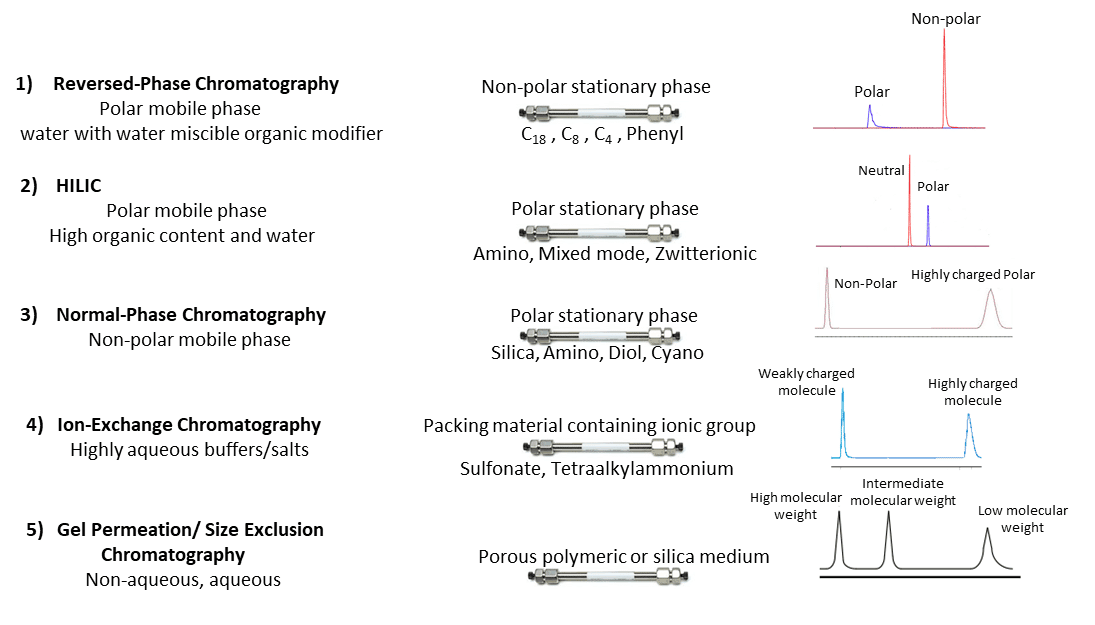
The tables below outline the HPLC mode selection approach according to physicochemical properties of the target analytes, including molecular weight and solubility¹:
| Molecular Weight ˂ 2000 |
Solubility |
Type of Solvent |
HPLC Mode |
| Organic | Non-Polar | Normal Phase | |
| Water Miscible | Reversed Phase | ||
| HILIC (for weak retention in RP) | |||
| THF | Gel Permeation (small molecules) | ||
| Aqueous | Non-ionic | Reversed Phase | |
| HILIC (for weak retention in RP) | |||
| Ionic | Ion Exchange | ||
| Reversed Phase with Ionization Control | |||
| Reversed Phase with Ion-Pair Agent |
| Molecular Weight ˃ 2000 |
Solubility |
HPLC Mode |
| Organic | Gel Permeation | |
| Aqueous | Ion Exchange with Wide-Pore Material | |
| Size Exclusion Chromatography | ||
| Reversed-Phase with Wide-Pore Material |
Various stationary phases are available in each of the modes, depending on the specific interactions of the target analytes. Here we provide some examples of how a selection of suitable stationary phase in each of the HPLC modes can effectively enhance the required chromatographic features for the method of interest.
In the case of RP chromatography, different alkyl chain lengths of hydrophobic silica packing material are available, including C₁₈, C₈, and C₄ as well as phenyl or diphenyl functionalized hydrophobic silica. The chromatograms below demonstrates the separation of the group of analytes in RP mode using different alkyl chain lengths of hydrophobic silica phases². Notice that the separation time can be modulated from C₄ to C₁₈; for instance, a C₄ or C₈ phase would be a better choice for the separation of the highly hydrophobic analytes with a stronger retention on C₁₈.
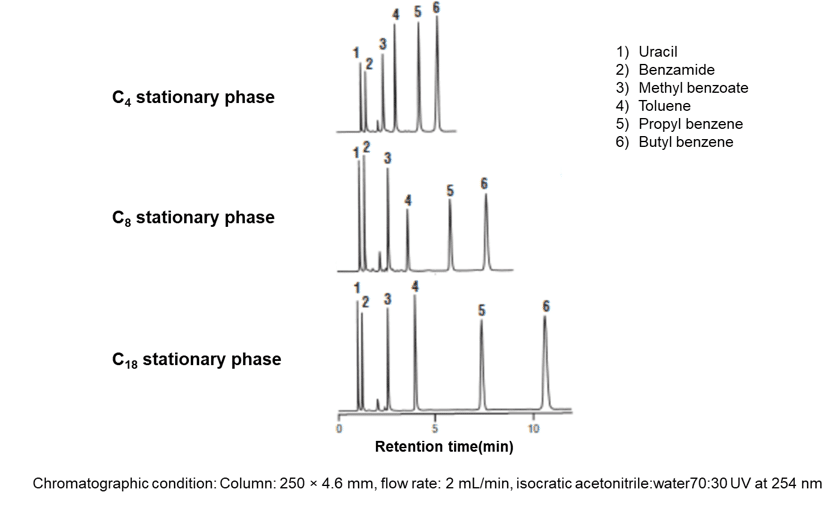
For a hydrophobic compound containing aromatic moiety, a phenyl or diphenyl functionalized C₁₈ silica phase offers better selectivity than a regular C₁₈ phase. As shown in the chromatogram below, the separation of the positional isomers would be significantly enhanced using the phenyl modified phase³:
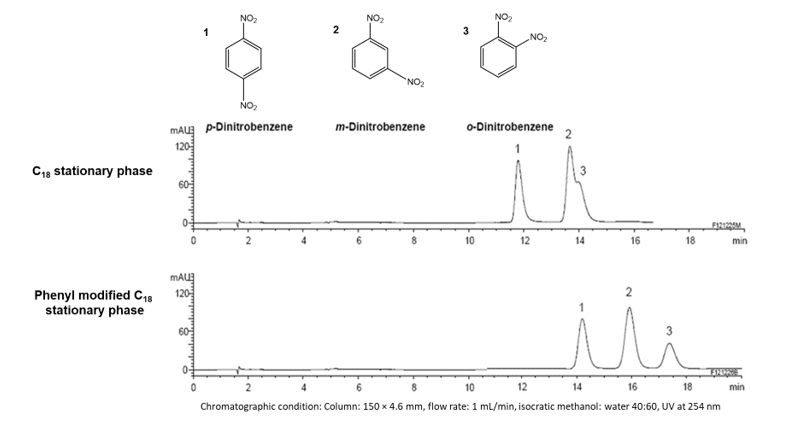
In the case of NP, various stationary phases with different polarities are available. These include bare silica, bonded amino, diol, and cyano modified silica packing material. Different bonding chemistries of bare silica with different degrees of polarities can be used as alternative phases when the separation of target analytes are difficult to achieve. As shown in the chromatogram below, bonded diol silica phase offers better separation of the analytes compared to the bare silica phases due to the presence of H-bonding interactions of the diol-modified phase with the analytes⁴:
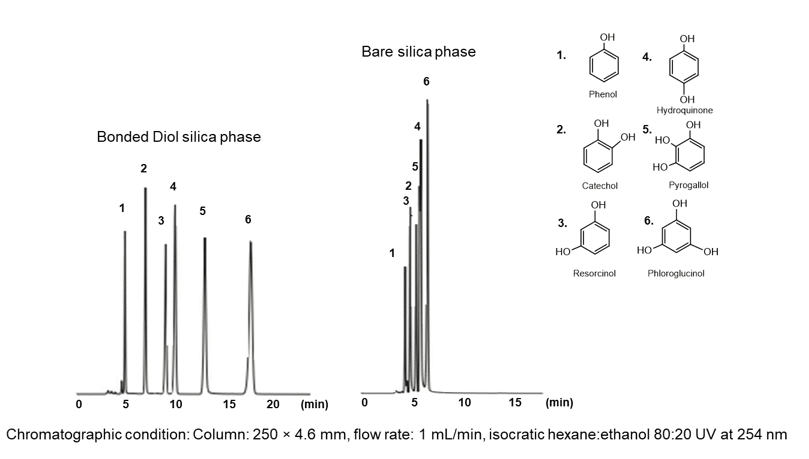
It is worth mentioning that separation of the target analytes may be achieved by using more than one mode of HPLC. Many separation scientists choose a suitable stationary phase based on analysis time, chromatographic parameters, and availability of the phase. For instance, size-exclusion chromatography (SEC) and ion-exchange chromatography (IEC) can be used for peptide and protein analysis. SEC is used to separate protein molecules by their size. In order to do that, a size exclusion column contains porous particles with different pore sizes. Typically, larger protein molecules cannot enter these pores and therefore flow past the particles, which would then result in faster elution, whereas small molecules can enter these pores and get briefly trapped in the particles, which results in later elution. The chromatogram below represents a size exclusion separation of albumin protein in the presence of its aggregate and albumin dimer⁵:
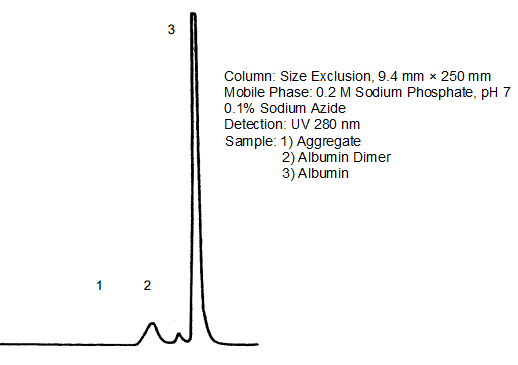
In the case of IEC, the proteins are separated based on their surface charges and electrostatic interactions with the ion exchange stationary phase. As it is shown in the chromatogram below, a cation exchange column is used to separate basic proteins⁶. The separation progresses by increasing salt concentration over the run time, where the positively-charged sodium ions replace more and more bound positively-charged protein molecules to negatively-charged stationary phase.
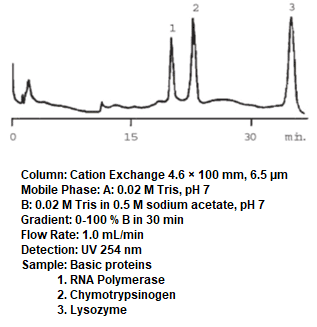
At Emery Pharma, we are dedicated to helping you solve challenges in drug development, medical devices, clean tech, solar energy and more. If you are interested in our HPLC services and methods, please visit our chromatography page. For other questions or information, please contact us at: info@emerypharma.com.
References:
- www.agilent.com/cs/library/primers/Public/LC-Handbook-Complete-2.pdf
- “Reversed-Phase Liquid Chromatography (RP-LC).” http://www.chromatographyshop.com/
- Comparison of Selectivity Differences Among Different Agilent ZORBAX Phenyl Columns using Acetonitrile or Methanol, Agilent Technologies Publication, 5990-4711EN
- www.ymc.co.jp/en/download/pdf/pdf03.pdf
- www.agilent.com/cs/library/eseminars/Public/Column%20Choices%20for%20proteins_037214.pdf
- DeLeenheer, A.P. et al. J. Pharm Sci., (1991) 80, 11.
